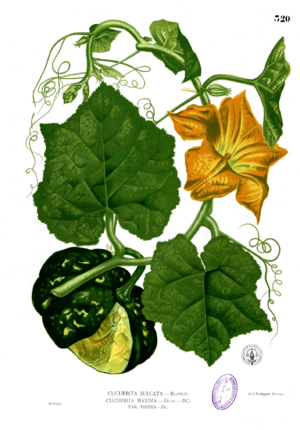Cucurbita maxima facts for kids
Quick facts for kids Cucurbita maxima |
|
|---|---|
 |
|
| Scientific classification | |
| Genus: |
Cucurbita
|
| Species: |
maxima
|
| Subspecies | |
|
|
| Synonyms | |
|
|
Cucurbita maxima is a type of squash that people grow. It's one of the most varied kinds of squash. This plant first grew in South America over 4,000 years ago. It came from a wild plant called Cucurbita andreana. These two plants can easily mix, but they have different amounts of calcium. All known Cucurbita maxima plants grow as long vines.
Contents
Discover Different Kinds of Cucurbita maxima
Many different types of Cucurbita maxima have been created over time. Even though some young plants might look like bushes, older plants grow like wild vines.
- Arikara squash is an heirloom type of C. maxima. Its fruits usually weigh between four and eleven pounds. They can be tear-drop shaped or round. Their skin is a mix of orange and green colors. People like this squash for eating and for decorating during holidays. This type of squash was first grown by the Arikara tribe in the Dakotas before white settlers arrived.
- Banana squash has a long shape. Its skin can be light blue, pink, or orange, and its inside flesh is bright orange.
- Boston marrow is a sweet-tasting squash. It is narrow at one end and wider at the other.
- Buttercup squash is a common type. It has a flat top, like a turban, and dark green skin. It usually weighs three to five pounds and has dense, yellow-orange flesh. Don't confuse it with butternut squash!
- Candy Roaster squash is a special type that was first grown by the Cherokee people in the southern Appalachians. This heirloom squash can be very different in size (from 10 to over 250 pounds!), shape (round, long, tear-drop, or blocky), and color (pink, tan, green, blue, gray, or orange). Most have fine, orange flesh. This squash is still very popular, especially in the southern Appalachians.
- Hubbard squash is another type of C. maxima. It usually has a tear-drop shape. People often use it instead of pumpkins in cooking. One story says the name came from Bela Hubbard, a settler in Randolph Township, Ohio. Other stories say the squash came to Marblehead, Massachusetts by Captain Knott Martin. A woman named Elizabeth Hubbard showed the squash to her neighbor, James J. H. Gregory, who sold seeds. Mr. Gregory then started selling it and named it after Mrs. Hubbard. Later, Gregory created the blue hubbard, which has bluish-gray skin. The golden hubbard squash has bright orange skin. Gregory advertised this squash as early as 1859.
- Jarrahdale pumpkin is a pumpkin with gray skin. It looks very much like 'Queensland Blue' and 'Sweet Meat' varieties.
- Kabocha is a Japanese type of squash. It has dark green skin and bright golden-orange flesh.
- Lakota squash is an American type.
- Nanticoke squash is a rare heirloom type. It was traditionally grown by the Nanticoke people of Delaware and Eastern Maryland. It is one of the few native winter squashes from the Eastern woodlands that still exists today.
- Turban squash, also called "French turban," is an heirloom squash that existed before 1820. It is closely related to the buttercup squash.
How People Use Cucurbita maxima
Buttercup squash, a common type, can be roasted, baked, or mashed into soups. It is very popular, especially as a soup, in Brazil, Colombia, and Africa.
All giant pumpkins, which weigh over 100 pounds, are of this species. The biggest pumpkins ever recorded were C. maxima. In 2020, one weighed 2,624.6 pounds!
The seeds of C. maxima are sometimes used to help treat parasites in animals.
Where Cucurbita maxima Grows
All types of squashes and pumpkins come from the Western Hemisphere. C. maxima likely started in northern Argentina near the Andes mountains. When the Spanish arrived, they found it growing there. It has not been found growing wild anywhere else.
This plant needs a lot of hot weather to grow best. Because of this, it doesn't grow very well in northern Europe, the British Isles, or other places with short or cool summers.
Different types of this squash were brought to North America as early as the 1500s. By the time of the American Revolution, Native American tribes across what is now the United States were growing this plant. In the early 1800s, at least three types were sold in North America from seeds that came from Native Americans. Other places where many different types of C. maxima are found include India, Bangladesh, Myanmar, and possibly the southern Appalachians. The large red-orange squashes you often see at Halloween in the United States are C. maxima. However, don't confuse them with the orange pumpkins used for jack-o'-lanterns, which are a different species called C. pepo.
Images for kids
See also
 In Spanish: Cucurbita maxima para niños
In Spanish: Cucurbita maxima para niños











